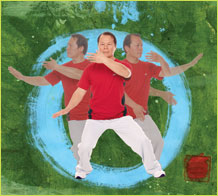Just about everyone can improve their health with tai chi. Learn how to get started.
In ancient China, there was once a physician, Hua-tu'o, who believed in using both exercise and medicine to heal the body and keep it healthy. He taught his patients the movements of a tiger, deer, bear, ape, and bird, which exercised every joint in the body. Hua-tu'o believed that imitating these movements improved digestion and circulation, and helped his patients to live long, healthy lives.
This is just one of many legends attempting to explain the origin of tai chi. While there are many views about how tai chi began, everyone seems to agree on its benefits. Whether you'd like to improve your agility as an athlete, lower your blood pressure, reduce chronic pain, or just stay healthy, tai chi can help you to do it.
"Tai chi is a healing martial art that flows like water," says Wen-Ching Wu.
A grand champion in martial arts, Wen-Ching has written and coauthored a number of books, including Tai Chi Beginning: A Complete Workout Reference for Beginners. Today, he teaches tai chi and a range of other martial arts at his studio in East Providence, Rhode Island, The Way of the Dragon.
Commonly known as a moving meditation, tai chi is done standing in sets of rhythmic movements called forms. Each movement flows into the next. Done slowly for beginners, and faster for advanced students, forms involve all major muscle groups and include stepping forward and back, pushing and pulling, bending, squatting, lunging, kicking, and more. In the Yang style of tai chi, there are 64 forms, but beginners usually focus on the 24-movement short form.
In China, athletes use tai chi to improve their performance and achieve greater physical ability. It's also common to see the Chinese practicing tai chi in parks, swaying in unison with their instructor.
Studies in the United States have proven that tai chi improves overall well-being and reduces lower back pain, headaches, stress, depression, blood pressure, and incidences of falls. The health benefits of tai chi are touted by the American Heart Association, the American Diabetes Association, and the Arthritis Foundation.
Clearly something's going on
Masters and long-time students of tai chi will tell you that "something" is "ch'i" (sometimes spelled "qi," but always pronounced "chee"). Ch'i is an inner energy that everyone possesses, but few know how to direct. "Tai chi helps students create positive energy in their bodies and deflect negative energy from the outside," says Wen-Ching. "They learn to direct the energy in their bodies, which helps to achieve balance."
Isn't this sounding a bit "new agey"?
"Do you question electricity?" asks Gail Whitsitt-Lynch, who is also a tai chi master. "People are basically electrical. We are moving space around in our bodies. Some of that is energy. Some is solid."
Studies have yet to prove exactly what changes take place in the body as a result of practicing tai chi. That's why the National Center for Complementary and Alternative Medicine, a branch of the National Institutes of Health, is sponsoring research to learn more.
To learn more, you can browse your local library and bookstore for guides and DVDs. And remember to visit National Center of Complementary and Alternative Medicine.





